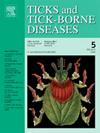Ticks and tick-borne pathogens on Belle-Île-en-Mer: An exploratory study in a western French island environment
IF 3.1
2区 医学
Q2 INFECTIOUS DISEASES
引用次数: 0
Abstract
The islands of Brittany provide unique ecosystems for ticks and tick-borne diseases owing to their oceanic climate, influencing interactions among ticks, hosts, and pathogens. We conducted a preliminary investigation on Belle-Île-en-Mer, an island off the Atlantic coast of Brittany in western France, to assess the prevalence of questing adult ticks and associated human pathogenic bacteria. Dermacentor spp. were found to dominate the tick population (61 %): 23 % Dermacentor reticulatus and 77 % D. marginatus. Haemaphysalis punctata (27 %) was also prevalent on the island, and Ixodes ricinus (12 %) was detected for the first time on Belle-Île-en-Mer. Both Dermacentor species harbored either Rickettsia slovaca (24 %) or Rickettsia raoultii (20 %), whereas I. ricinus carried Borrelia burgdorferi sensu lato and Anaplasma phagocytophilum but not Borrelia miyamotoi or Neoehrlichia mikurensis. Detection of two potentially pathogenic species in the B. burgdorferi sensu lato complex, B. afzelii and B. lusitaniae, along with A. phagocytophilum underscores the current risk of Lyme borreliosis and anaplasmosis. The high prevalence of Rickettsia infection in Dermacentor indicates an additional risk of human rickettsioses.
贝勒岛上的蜱虫和蜱传病原体:对法国西部岛屿环境的探索性研究
布列塔尼群岛的海洋性气候为蜱虫和蜱传疾病提供了独特的生态系统,影响了蜱虫、宿主和病原体之间的相互作用。我们对法国西部布列塔尼大西洋沿岸的贝勒Île-en-Mer 岛进行了初步调查,以评估觅食成蜱和相关人类致病菌的流行情况。结果发现,蜱虫中主要是皮囊蜱(61%):23%为网纹皮囊蜱,77%为边缘皮囊蜱。点状蜱(Haemaphysalis punctata)(27%)在岛上也很普遍,而蓖麻蜱(Ixodes ricinus)(12%)则是首次在贝勒岛上发现。这两种皮囊动物都携带有Rickettsia slovaca(24 %)或Rickettsia raoultii(20 %),而蓖麻线虫携带有Borrelia burgdorferi sensu lato和噬细胞嗜血杆菌,但没有携带Borrelia miyamotoi或Neoehrlichia mikurensis。在正常鲍曼不动杆菌复合体中发现了两个潜在的致病物种:B. afzelii 和 B. lusitaniae,以及噬细胞嗜酸性阿纳疟原虫,这突显了当前莱姆病和无形体病的风险。皮acentor 的立克次体感染率很高,这表明人类立克次体病的风险增加了。
本文章由计算机程序翻译,如有差异,请以英文原文为准。
求助全文
约1分钟内获得全文
求助全文
来源期刊

Ticks and Tick-borne Diseases
INFECTIOUS DISEASES-MICROBIOLOGY
CiteScore
6.90
自引率
12.50%
发文量
185
审稿时长
6-12 weeks
期刊介绍:
Ticks and Tick-borne Diseases is an international, peer-reviewed scientific journal. It publishes original research papers, short communications, state-of-the-art mini-reviews, letters to the editor, clinical-case studies, announcements of pertinent international meetings, and editorials.
The journal covers a broad spectrum and brings together various disciplines, for example, zoology, microbiology, molecular biology, genetics, mathematical modelling, veterinary and human medicine. Multidisciplinary approaches and the use of conventional and novel methods/methodologies (in the field and in the laboratory) are crucial for deeper understanding of the natural processes and human behaviour/activities that result in human or animal diseases and in economic effects of ticks and tick-borne pathogens. Such understanding is essential for management of tick populations and tick-borne diseases in an effective and environmentally acceptable manner.
 求助内容:
求助内容: 应助结果提醒方式:
应助结果提醒方式:


